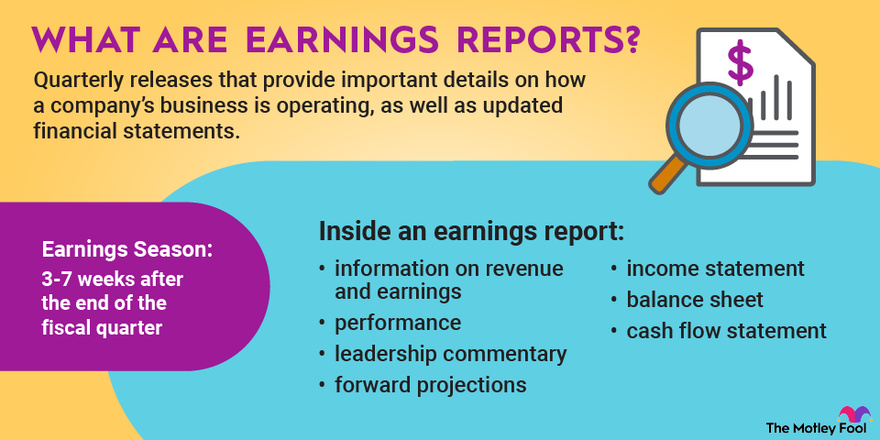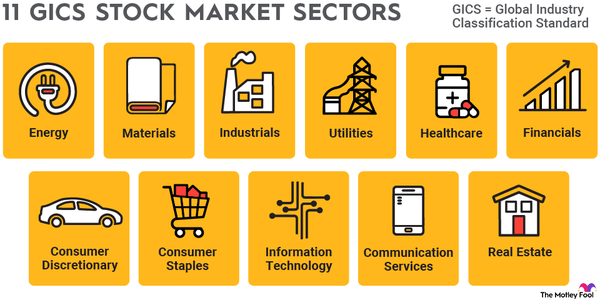Earnings reports are some of the most important sources of information available to stock investors. They give important details about the current state of a business, reveal important financial information, and may include forward earnings and revenue projections, as well as commentary by the CEO or other company leaders.

If you're invested in a particular stock, reading its quarterly and year-end earnings reports is one of the smartest things you can do to ensure your investment is still a good one. If you aren't invested in a company, reading through its recent earnings reports can help you analyze profitability, growth, financial conditions, and other important information to make educated decisions about whether a company would be a good fit for your portfolio.
What are they?
What are earnings reports?
Earnings reports are (usually) quarterly releases that provide important details on a company's business operations and updated financial statements.
Publicly traded companies in the United States are generally required to issue earnings reports once per quarter to disclose and discuss their quarterly and full-year business results to the investing community. They must be issued in a timely manner after the end of the period being reported.
Most (but not all) companies release their earnings reports within three to seven weeks after the end of the fiscal quarter. This period that occurs after each calendar quarter is often referred to as earnings season.
In a company's earnings report, you can find information on its revenue (also known as top line) and earnings (bottom line) and how specific parts of the company performed.
Most companies provide commentary from senior leadership on the results and valuable context about future growth initiatives. These typically come both in the form of comments in the written earnings report and in an earnings conference call, which usually occurs within a day or so after the earnings report is released. Many provide forward projections, or guidance, which tell investors how management expects the business to perform in the coming quarter or for the full year.
Upcoming reports
Upcoming critical earnings reports in 2025
Thousands of stocks trade on the New York Stock Exchange (NYSE) and Nasdaq exchanges in the United States, and thousands more trade on over-the-counter (OTC) markets and on international stock exchanges. So, it's impossible for us to discuss all of them. However, here's a list of some of the most closely followed companies when it comes to earnings reports and when investors can expect to hear from them next.
| Name (Ticker Symbol) | Market Cap |
Upcoming Earnings Date |
|---|---|---|
|
Amazon (NASDAQ:AMZN) |
$2.30 trillion | 7/30/2025 |
|
Tesla (NASDAQ:TSLA) |
$1.06 trillion | 7/21/2025 |
| Microsoft (NASDAQ:MSFT) | $3.56 trillion | 7/28/2025 |
| Berkshire Hathaway (NYSE:BRK.A)(NYSE:BRK.B) | $1.06 trillion | 8/1/2025 |
| Nvidia (NASDAQ:NVDA) | $3.54 trillion | 8/27/2025 |
| Alphabet (NASDAQ:GOOGL)(NASDAQ:GOOG) | $2.13 trillion | 7/21/2025 |
| Shopify (NYSE:SHOP) | $142 billion | 8/5/2025 |
| Block (NYSE:XYZ) | $40 billion | 7/30/2025 |
| Meta Platforms (NASDAQ:META) | $1.77 trillion | 7/29/2025 |
It's important to note that most companies don't announce their earnings release date until a few weeks before it happens. In many cases (including in the table above), earnings dates that are a month or more in the future are approximate and based on the company's previous earnings release activity.
Recent reports
Recent important earnings reports
For the nine stocks in the earnings calendar chart above, here's a rundown of how things went the last time they reported earnings.
1. Amazon
Amazon reported its first-quarter earnings on May 1, 2025, and the results were generally strong. Revenue surpassed analysts' expectations, and the company's cost-cutting efforts resulted in excellent profit margin growth. In fact, Amazon's net income increased by more than 60% year-over-year.
Amazon Web Services (AWS) was an especially strong point, with revenue up 17% year over year. One thing to keep an eye on is Amazon's capital expenditures, which have accelerated recently due to AI-related investments in data centers and related equipment. Management has said that the company expects capital expenditures to increase to $100 billion in 2025 (compared to $83 billion in 2024), so this is definitely something to keep an eye on.
2. Tesla
In the first quarter of 2025, Tesla reported a 20% year-over-year decrease in automotive revenue, which missed analysts' expectations by a significant margin. The EV maker missed expectations on the bottom line, as well. The biggest drag was reduced vehicle selling prices, which weighed on margins, while increased selling incentives and preparations for a refreshed Model Y also held earnings down.
Plus, Tesla reported a 71% year-over-year net income decline, which was a big disappointment to investors.
3. Microsoft
In its fiscal third quarter of 2025 (its fiscal year ends June 30), Microsoft reported $70.1 billion in total revenue, which topped expectations. Plus, the company's forward guidance was significantly more than analysts had expected for the fourth fiscal quarter, led by strong growth in Azure.
On the bottom line, Microsoft's earnings came in better than expected, with $3.46 per share in net profit. Azure revenue grew 33% year-over-year, with about half of the increase directly associated with artificial intelligence (AI) demand.
4. Berkshire Hathaway
Berkshire Hathaway is one of the few companies that always reports earnings on Saturdays, as management wants the market to have time to digest it before trading opens on Monday. In the first quarter of 2025, Berkshire reported a 14% year-over-year earnings decline in its operating businesses, mainly due to weaker underwriting profits from insurance.
Warren Buffett and his team continue to be net sellers of stock, and as a result, Berkshire reported an all-time high cash and short-term investments balance of about $348 billion, giving the company tremendous financial flexibility going forward.
5. Nvidia
For the first quarter of its 2026 fiscal year, graphics chipmaker Nvidia reported both revenue and earnings that handily surpassed expectations. It generated $44.1 billion in revenue and expects this to swell to $45 billion in the second fiscal quarter. Nvidia's revenue continues to grow rapidly, with 69% year-over-year growth in the first quarter, thanks to the continued surge in demand for AI chips.
Nvidia has been a major beneficiary of the surge in AI investment, and this has been fueling rapid growth in recent quarters. However, there are some concerns about the company's ability to sustain its growth. On the other hand, the industries it serves are expected to get significantly larger over the next decade, so there could be plenty of profit growth in the years ahead.
6. Alphabet
In the first quarter of 2025, Alphabet (better known for its main subsidiary, Google) reported both revenue and earnings that exceeded analysts' expectations.
Looking a little deeper, revenue from the fast-growing Google Cloud business slightly missed expectations, as did YouTube advertising revenue. It's also important to mention that Alphabet expects $75 billion in capital expenditures in 2025, mainly having to do with its AI growth strategy. This is far more than investors had been expecting, so it will be important to watch and see if the company can achieve a strong return on its investment.
However, it's important to note that the board authorized another $70 billion in stock buybacks, so the company's leaders appear to think the stock is still attractive.
7. Shopify
E-commerce service platform Shopify issued mixed results and relatively weak guidance. Shopify guided for second-quarter gross profit growth at a "high-teens" percentage, less than the roughly 20% analysts had been expecting.
Management said that some of the Trump administration's policies, such as de minimis tariffs, aren't having much of an impact on Shopify, so there was some good news. There are still some ongoing concerns about discretionary spending, but Shopify is doing a great job of setting itself up for long-term success regardless of short-term headwinds.
8. Block
Despite fears of lower consumer spending, fintech giant Block (formerly Square) reported solid first-quarter 2025 results throughout its business. Gross profit increased by 9% year over year, and while revenue came in a bit light, the business has become far more profitable than it was a year ago.
On the other hand, the company provided soft profit guidance for the second quarter due to economic uncertainty, so it will be interesting to keep an eye on the company for the rest of 2025. Block's Cash App Card is a particularly interesting point to watch, as it is growing its active user base rapidly and creating many opportunities to cross-sell new products.
9. Meta Platforms
Meta Platforms, better known by its former name, Facebook, reported first-quarter 2025 earnings that handily beat expectations on both the top and bottom lines. Revenue in the fourth quarter increased by 16% year-over-year, and net income reached $16.6 billion -- 35% more than the same quarter a year ago.
Meta increased guidance for its (mostly) AI-related capital expenditures, now projecting they will be in the range of $64 billion to $72 billion for the full year 2025, up $5.5 billion at the midpoint of the range. There are 3.43 billion daily active users on the company's platforms, which also exceeded analyst expectations.
Related investing topics
Their importance
Why are earnings reports important?
Earnings reports are important because they provide lots of important insights into the current state of the companies you invest in and clues about where those companies could be heading. Among other things, earnings reports can help you spot growth trends, profit margin growth or contractions, balance sheet health, and how management expects the business to perform going forward.
It's also important to note that earnings reports generally coincide with a conference call with the company's management team and analysts who cover it (also known as an earnings call). These can also be worth listening to, as the company's key executives can provide context and commentary about the numbers you read in their earnings reports.
Earnings Call
With most U.S. companies, earnings reports are the most up-to-date look investors will get at a company's business and financials. Reading the most recent earnings report is an important part of doing ongoing due diligence as a buy-and-hold investor and can help you find new investment opportunities.
How to identify potential concerns in a company's earnings report
There's no perfect way to identify red flags in a company's earnings report, and it's important to evaluate any concerning information in context with the industry conditions, macroeconomic environment, etc.
Having said that, here are a few things to watch out for:
- Slowing earnings growth.
- Missed guidance (revenue or earnings).
- Reduced guidance.
- Margin compression that isn't for some valid reason.
FAQ
Earnings reports FAQ
How do investors use earnings reports?
Aside from the obvious use of seeing how a company's business performed over the past three-month period, there is plenty of valuable information in earnings reports. For example, the company's balance sheet gives an updated look at the financial condition of the business. Management's guidance gives you a look at where things might be heading in the future. And investors can use the numbers to spot trends, such as accelerating or slowing growth rates, margin trends, etc.
What time are earnings reports released?
There's no specific rule governing the timing of earnings reports, but most companies choose to release their results within a few hours before the stock market opens or after it closes. Most earnings reports are released in the 6 a.m. to 8:30 a.m. ET or 4 p.m. to 5 p.m. ET windows, but there certainly are exceptions.
Where can I find earnings reports?
There are a few places where you can find earnings reports. The easiest place is typically on the company's investor relations page, but you can also look at the company's filings with the Securities and Exchange Commission (SEC). Alternatively, if you have a brokerage account, you can typically see all recent news (including earnings releases) in a company's news feed.
How much do earnings reports affect stock prices?
Earnings reports can certainly influence stock prices, but this isn't always the case. If a company misses expectations on earnings or revenue, reports an unexpectedly strong or weak quarter, or issues future guidance that is either worse or better than expected, its stock price could move sharply in one direction or another. On the other hand, if a company's earnings report is completely lacking in surprises, it's entirely possible for a stock to barely budge after earnings.












